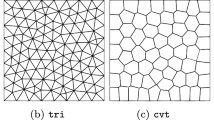Abstract
This paper deals with the efficient and accurate computation of extracellular potentials in a simplified model of myocardial tissue. The electrical activity of the heart is characterized by a narrow wavefront spreading through the myocardium. To increase the accuracy of the computation, a non-conforming non-overlapping domain decomposition based on the mortar method is used, allowing adaptivity in the regions closed to the wavefront. The benefits of the adaptive grid refinement process are illustrated by numerical results that show how the method works and its efficiency if compared to the classical conforming Finite Element Method.
Similar content being viewed by others
REFRENCES
Achdou, Y., Maday, Y., and Widlund, O. (1999). Substructuring preconditioner for the mortar method in dimension two. SIAM J. Numer. Anal. 36, 551–580.
Braess, D., Dahmen, D., and Wieners, C. (1999). A multigrid algorithm for the Mortar Finite Element method. SIAM J. Numer. Anal. 37, 48–69.
Bernardi, C., Maday, Y., and Petera, A. T. (1993). Domain decomposition by the mortar element method. In Kaper, H., et al. (eds.), Asymptotic and Numerical Method for Partial Differential Equations with Critical Parameters, Reidel, Dordrecht, pp. 269–286.
Bernardi, C., Maday, Y., and Petera, A. T. (1994). A new nonconforming approach to domain decomposition: The mortar element method. In Brezis, H., and Lions, J. L. ((eds.)), Nonlinear Partial Differential Equations and their Applications, Collège de France Seminar, Notes Math. Ser. 299, Pitman-Boston, Vol. XI, pp. 13–51.
Bertoluzza, S., and Perrier, V. (2001). The mortar method in the wavelet context. M2AN 35, 647–674.
Bramble, J. H., Pasciak, J. E., and Schatz, A. H. (1986). The construction of preconditioner for elliptic problems by substructuring I. Math. Comp. 47, 103–134.
Cherry, E. M. (2000). A Space-Time Adaptive Mesh Refinement Method for Simulating Complex Cardiac Electrical Dynamics, Ph.D. thesis, Duke University.
Ciarlet, P. (1978). The Finite Element Method for Elliptic Problems, North-Holland.
Colli Franzone, P., Guerri, L., Pennacchio, M., and Taccardi, B. (1998). Spread of excitation in 3-D models of the anisotropic cardiac tissue II. Effects of fiber architecture and ventricular geometry. Math. Biosci. 147, 131–171.
Colli Franzone, P., Guerri, L., Pennacchio, M., and Taccardi, B. (1998). Spread of excitation in 3-D models of the anisotropic cardiac tissue. III: Effects of ventricular geometry and fiber structure on the potential distribution. Math. Biosci. 151, 51–98.
Colli Franzone, P., Guerri, L., and Rovida, S. (1990). Wavefront propagation in an activation model of the anisotropic cardiac tissue: asymptotic analysis and numerical simulation. J. Math. Biol. 28, 145–209.
Colli Franzone, P., and Savaré, G. (2002). Degenerate evolution systems modeling the cardiac electric field at micro and macroscopic level, Evolution Equations, Semigroups and Functional Analysis: In Memory of Brunello Terreni, Progr. Nonlinear Differential Equations Appl., Vol. 50, Birkhäuser, Basel, pp. 49–78.
Henriquez, C. S. (1993). Simulating the electrical behavior of cardiac tissue using the bidomain model. Crit. Rev. Biomed. Engr. 21, 1–77.
Henriquez, C. S., Muzikant, A. L., and Smoak, C. K. (1996). Anisotropy, fiber curvature, and bath loading effects on activation in thin and thick cardiac tissue preparations: Simulations in a three-dimensional bidomain model. J. Cardiovasc. Electrophysiol. 7(5), 424–444.
Hooke, N. F. (1992). Efficient Simulation of Action Potential Propagation in a Bidomain, Ph.D. thesis, Duke University.
Hooke, N., Henriquez, C., Lanzkron, P., and Rose, D. (1994). Linear algebraic transformations of the bidomain equations: implications for numerical methods. Math. Biosci. 120, 127–145.
Keener, J. (1991). An eikonal-curvature equation for action potential propagation in myocardium. J. Math. Biol. 29, 629–651.
Keener, J., and Bogar, K. (1998). A numerical method for the solution of the bidomain equations in cardiac tissue. Chaos 8(1), 234–241.
Pennacchio, M. (2001). A non-conforming domain decomposition method for the cardiac potential problem. Computers in Cardiology 2001; IEEE Proc. 28, 537–540.
Pennacchio, M., and Simoncini, V. (2002). Efficient algebraic solution of reaction–diffusion systems for the cardiac excitation process. J. Comput. Appl. Math. 145(1), 49–70.
Pormann, J. B. (1999). A modular simulation system for the bidomain equations, Ph.D. thesis, Dept. of Electrical and Computer Engineering, Duke University.
Quan, W., Evans, S. T., and Hastings, H. M. (1998). Efficient integration of a realistic two-dimensional cardiac tissue model by domain decomposition. IEEE Trans. Biomed. Eng. 45(3), 372–385.
Saleheen, H. I., and Ng, K. T. (1998). A new three-dimensional finite difference bidomain formulation for the inhomogeneous anisotropic cardiac tissues. IEEE Trans. Biomed. Eng. 45(1), 15–25.
Vigmond, E. J., and Josh Leon, L. (1999). A computationally efficient model for simulating electrical activity in cardiac tissue with fibre rotation. Ann. Biomed. Eng. 27, 160–170.
Wohlmuth, B. I. (2001). Discretization Methods and Iterative Solvers Based On Domain Decomposition, Lecture Notes in Computational Science and Engineering, Vol. 17, Springer.
Author information
Authors and Affiliations
Rights and permissions
About this article
Cite this article
Pennacchio, M. The Mortar Finite Element Method for the Cardiac “Bidomain” Model of Extracellular Potential. Journal of Scientific Computing 20, 191–210 (2004). https://doi.org/10.1023/B:JOMP.0000008720.85771.d0
Issue Date:
DOI: https://doi.org/10.1023/B:JOMP.0000008720.85771.d0




